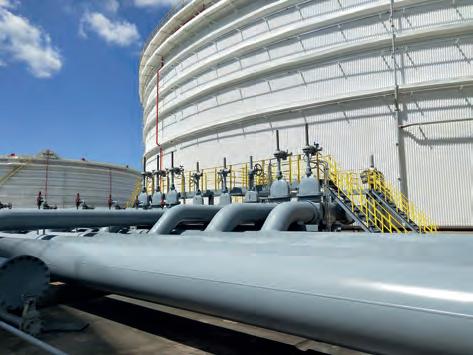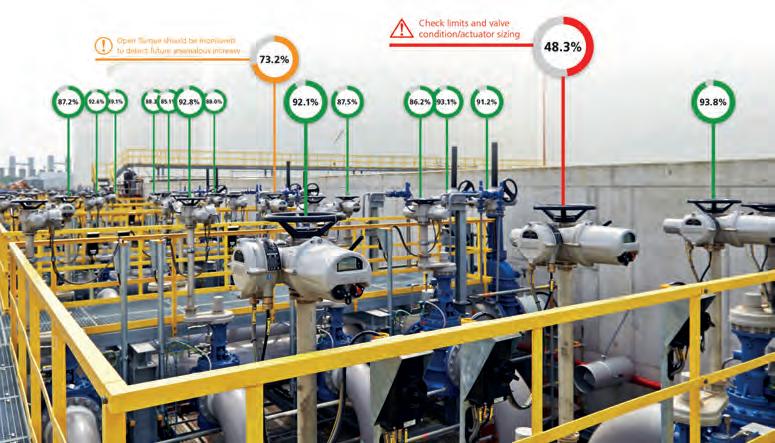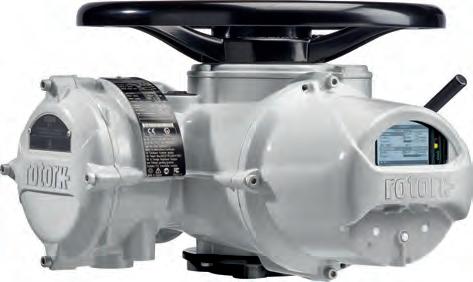
8 minute read
Keeping things operating smoothly
Dave Godfrey, Rotork, UK, discusses how downstream oil and gas operators can support ageing assets and reduce downtime.
Refineries and associated downstream applications are complex systems that require specialist equipment to run smoothly and to support continuously high production demands. A key element within this is flow control. Actuators control the valves that allow oil and gas to be produced, transported, stored, refined and sold. Effective flow control provides high degrees of reliability, repeatability, accuracy, safety and efficiency. Actuators are seen in a diverse range of applications within oil and gas, stretching from wellheads to tank farms, and pipelines to refineries. They provide day-to-day flow control and safety functions in these challenging environments. Actuators are therefore a common sight on downstream sites such as refineries. The exact role that they play can differ, depending on customer requirements. For example, thousands of Rotork IQ3 intelligent electric actuators control a variety of gate, ball and butterfly valves to manage the flow of crude oil at a refinery and petrochemical site on the island of Zhoushan, near Shanghai, China. This site refines
oil and manufactures ethylene. Control networks are often required onsite because of the number of actuators installed. These are communication networks that transmit information between devices. A project to provide flow control at a Turkish refinery (creating products such as petrol, naphtha, aviation fuel, kerosene and diesel) has over 900 IQ3 actuators from Rotork onsite. They were installed to automate valves that were previously manually operated. The actuators in different areas of the refinery are monitored and controlled by Rotork’s PakscanTM control network.
Electrification is emerging as a major theme in the race to net zero, and can play an important role in the reduction of emissions within oil and gas operations. This is a sector – regardless of which stream an application sits under – that is under increasing scrutiny to reduce damaging emissions and to transform in order to remain as an important factor within the energy transition. Oil and gas operations will remain important for many years to come; the electrification of processes within it (such as flow control) is an obvious way to reduce environmental impact. Electric actuators are increasingly chosen within oil and gas because they do not release emissions during operation, compared to more traditional forms of flow control (especially pneumatic actuators) that can vent methane or other damaging gases into the atmosphere.
Another critical role played by actuators in downstream actuators is safety provision. Emergency shutdown (ESD) or fail-safe requirements are often key considerations for plant managers when they choose what form of flow control they need. Safety functionality allows for operations to quickly stop the flow of oil or gas. Continued flow in downstream applications can have safety, financial and reputational consequences. Appropriate safety/shutdown systems provided by an actuator means that impacts are reduced or nullified and the flow of gas or oil can be safely controlled.
For example, the Karbala Refinery in Iraq, due to begin operation this year, will produce petrol, gas oil, fuel oil, jet fuel and asphalt. IQ3 actuators were ordered to support the reliable, efficient and safe operation of the refinery. This includes the provision of an ESD function. The actuators are certified for safety applications (SIL2/3).
Another actuator that is often specified for safety functions are spring-return actuators. These can be seen in all streams of oil and gas operations, but most commonly in midstream applications such as pipelines. These fluid-powered actuators are a simple and reliable option. They are ideal for remote or hazardous environments. In remote or extreme conditions (such as pipelines and unmanned sites), the additional possibility of environmental impacts must be considered, as considerations of safety and shutdown are just as important here as they are in a refinery.

The importance of holistic maintenance plans to prevent downtime
Figure 1. IQ3 actuators from Rotork onsite at a Chinese refinery.
It is clear how important effective flow control is within downstream oil and gas applications. Sites rely on actuators working effectively every day. The availability of flow control assets should always be a focus for plant managers; uptime is key in achieving productivity and profitability. Sites only run efficiently, without costly downtime, if assets are continually available. When assets are unexpectedly unavailable and a site suffers downtime, the impacts include poor performance, reduced yield, poor quality, financial losses and reputational damage. These impacts can occur even if assets are unavailable for only a short period of time. A Figure 2. An asset management system gathers performance data for analysis. holistic asset maintenance plan is therefore essential

if downtime is to be minimised. It is a critical consideration for long-term reliability and viability of continuing downstream applications. Site operators must choose an appropriate asset management plan that considers the entirety of a site for the long-term, including the total cost of ownership of an asset – from newly-purchased to the end of life.
The cost of not having a holistic maintenance plan can be high: if an asset breaks and there are no plans in place to fix it, then large amounts of money may be spent to get a site working again. An asset management system with a fixed cost means that service budgets will be stable, without costly unplanned work for the replacement of assets. A programme such as Rotork’s Lifetime Management looks at the entire life cycle of an asset (and the management of its potential obsolescence) and how this will impact the entire site. This system can increase uptime and eliminate unexpected maintenance costs.
Obsolescence management
Sites with flow control equipment require support to guide them through periods of change. As assets age, obsolescence becomes a concern. They must be carefully managed and plans should be made for the end of their life cycle. Over time, a decline in performance or an increase in the risk of operational failure is likely. Appropriate day-to-day maintenance plans are essential, but operators must plan beyond the functional life of an asset and have obsolescence plans in place that will ensure continued production and a reduction in downtime. The problems surrounding ageing flow control equipment are traditionally managed by spares and reactive maintenance. To ensure continued operation and effective performance, operators may need to consider updating technology to future-proof their sites. Critical obsolescence planning must be worked on in conjunction with flow control asset specialists.
An asset such as an actuator may have a life cycle of many decades. Spares for an ageing actuator often become increasingly difficult to source as supply chains undergo disruption and as technology and safety standards evolve. Other relevant factors in operators’ decision making may include regulatory compliance, up-to-date health and safety standards, budget issues, and struggles to continue with current maintenance or spares programmes. Proactive engagement in future-proofing sites, understanding the importance of obsolescence management, and managing the life cycle stage of assets will result in budget predictability, improved performance and reduced downtime.

Figure 3. IQ3 SET from Rotork.
Technological innovation
Technological innovations can manage obsolescence concerns. Lifetime Management from Rotork has now been enhanced by the launch of IQ3 SET, offering backwards compatibility to the 1960s. The use of IQ3 SET is appropriate for legacy actuators on sites that have non-integral starters. The feature option works with and supports the features of older actuators (such as A-Range actuators, amongst the first electric actuators on the market which can still be found on sites across the world today) with easy integration into existing plant architecture. This maintains and keeps actuators up-to-date and allows customers to focus on operational goals, without concerns about imminent obsolescence or the need to deal with constant spares updates or last time buy pressures.
Use of IQ3 SET ensures predictable maintenance within budget, improved performance and increased uptime. It future-proofs plants with these actuators without affecting the plant infrastructure, as it is compatible with existing site cabling and control systems (there is no need for new cabling costs). Upgrading to up-to-date technology to overcome obsolescence issues in this way allows for minimal interruption to production, and reduced downtime. As it is part of an existing product range, a full and comprehensive knowledge of service and maintenance already exists. For all oil and gas operations, this confidence of continuing production and management of obsolescence concerns is extremely valuable.
There are other different steps that site operators can take to ensure continued production. Unwanted interruption on downstream sites such as tank farms can be damaging to operators. This is likely to occur on sites with unreliable power supplies. To allow valves to operate, and production to continue for as long as possible, operators may choose a battery-operated actuator that can ensure continued operation until power is restored. Rotork’s Shutdown Battery is part of the IQT part-turn range of intelligent electric actuators. If power is lost, it can continue to function through an Uninterruptable Power Supply (UPS). This allows for continued use until battery charge is depleted. This is another example of how innovation in flow control technology can assist operators in the essential task of reducing the potential time that assets can be offline for. The Shutdown Battery can conversely be used to stop flow when required, in order to prevent safety or environmental damage. It can also be set as fail-close, stopping the process safely after interruption to power.
Conclusion
Management of obsolescence is an important consideration for oil and gas operators who wish to maintain efficient operation/production and minimise instances of downtime. In downstream applications, work in refineries is in high demand and operators know that maintaining high levels of uptime is essential. Flow control asset obsolescence concerns can be managed in a variety of ways, including upgrading to the latest technology to reduce asset unavailability and to conform to up-to-date safety standards.










